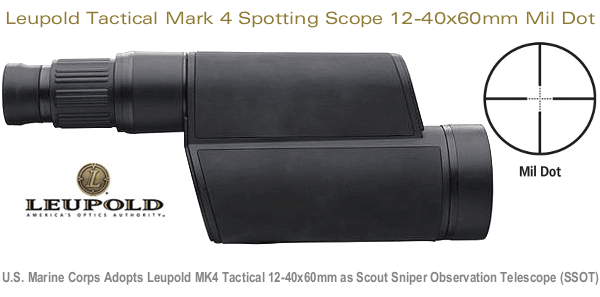September 4th, 2010
 Leupold’s Mark 4 Tactical Spotting Scope is now the standard Scout Sniper Observation Telescope (SSOT) of the U.S. Marine Corps, the first new spotting scope the Corps has used in decades. Leupold’s compact MK4 variable-power spotter replaces the fixed 20X M49 spotting scope fielded by the Marines since World War II. The Mark 4 Tactical spotter was also selected by the U.S. Army for use with its XM110 Semi-Auto Sniper System (SASS). This same Mark 4 spotting scope, with either Mil-dot or Horus reticles, is available for civilian purchase.
Leupold’s Mark 4 Tactical Spotting Scope is now the standard Scout Sniper Observation Telescope (SSOT) of the U.S. Marine Corps, the first new spotting scope the Corps has used in decades. Leupold’s compact MK4 variable-power spotter replaces the fixed 20X M49 spotting scope fielded by the Marines since World War II. The Mark 4 Tactical spotter was also selected by the U.S. Army for use with its XM110 Semi-Auto Sniper System (SASS). This same Mark 4 spotting scope, with either Mil-dot or Horus reticles, is available for civilian purchase.
Only 12.4 inches long, the MK4 spotting scope is extremely compact for its magnification level. Though it weighs just 37 ounces, it boasts a rugged, armored magnesium body that is nitrogen charged and 100% waterproof. Other good features of the MK4 include generous eye relief, multi-coated lenses, and rubber fold-down eyecups. A front focal plane (FFP) reticle magnifies the reticle along with the image, so users can estimate range at any power setting using the Mil Dot or Tactical Milling Reticle. CLICK HERE for full MK4 Spotting Scope Specs.

Folded Light Path Design Yields High Power in Small Package
By “folding” the entering light in a ‘Z’-path, the Newtonian-reflector design achieves high magnification in a very compact optic that is easy to pack and carry. Leupold’s efficient Folded Light Path (FLP) lens and mirror optical system allow the Mark 4 to deliver the effective optical path of a scope twice its length. We have also found that, compared to conventional spotting scopes, the Leupold spotter is more stable in windy conditions because it has much less overhang and a smaller cross-section than conventional designs. The folded-path Newtonian design makes perfect sense for spotting scopes that need to be carried in the field. A similar folded-light-path design is used in the superb, $5000.00 Zeiss Optronics 20-60x72mm Tactical Spotting Scope.
Leupold Now Offers Horus Reticle Options in MK4 Spotting Scopes
While the Marines use the MK4 Spotting scope with a conventional Mil Dot reticle, Leupold now offers Horus H32 and H36 ranging reticles as options. The H32 has a mil line for target measurement and speed estimation, while the H36 features an inverted “L” in Inch Of Angle (IOA) for easy ranging. The Mil Dot reticle matches those found in military riflescopes, allowing a spotter to quickly range a target, while viewing the same sight picture as the shooter. The Horus H32 and H36 provide a more complex grid that allows range estimation, target speed calculation, and 2nd-shot-correction.


To learn about more about the sophisticated Horus reticles, visit HorusVision.com.













 Leupold’s
Leupold’s 







